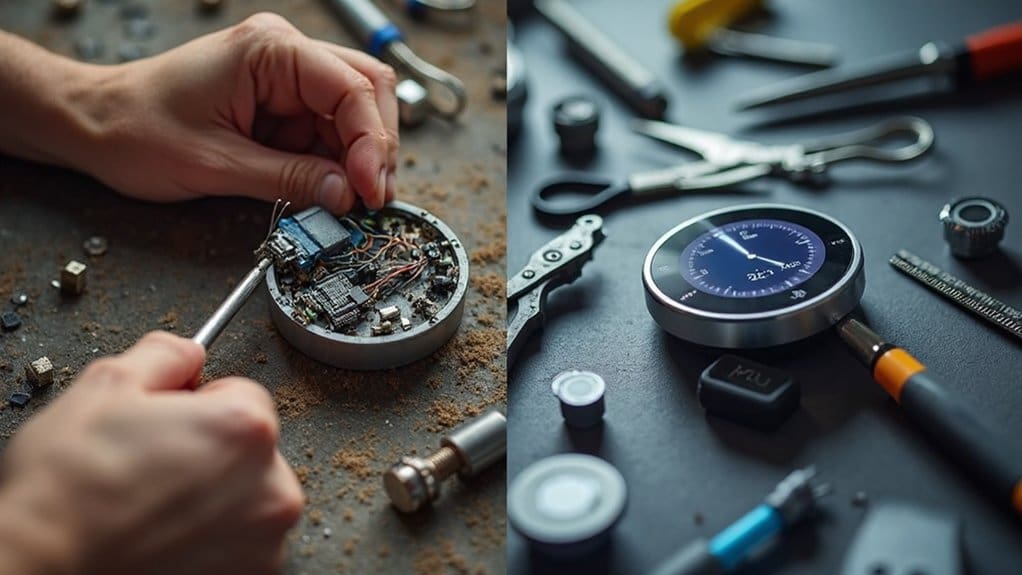You can safely handle basic thermostat maintenance like replacing batteries, checking settings, and cleaning dust from contacts. However, you’ll need professional help when encountering strange noises, burning odors, repeated circuit breaker trips, or refrigerant leaks. Amateur repairs risk electrocution from high-voltage wiring, fire hazards from improper connections, and carbon monoxide exposure from disrupted gas controls. Professional technicians bring specialized diagnostic tools, EPA certifications, and warranty protection that DIY attempts can’t match. Understanding these distinctions helps you make informed decisions about your home’s comfort system.
Key Takeaways
- Check thermostat batteries and settings first, as 70% of temperature control failures stem from dead batteries.
- Call professionals immediately for strange noises, burning odors, or repeatedly tripped circuit breakers indicating dangerous conditions.
- Avoid DIY repairs involving high-voltage wiring or gas systems due to electrocution and carbon monoxide risks.
- Professional technicians have EPA certifications, specialized diagnostic tools, and manufacturer-specific parts for proper repairs.
- DIY mistakes can void warranties and cause expensive system damage, making professional service more cost-effective.
Common Thermostat Problems You Can Fix Yourself
Several thermostat issues fall within the DIY repair category, provided you follow proper safety protocols and electrical codes. Start your basic maintenance by checking thermostat batteries, as dead batteries cause 70% of temperature control failures. Verify your thermostat settings are set correctly for your desired temperature and programming schedule. If your system isn’t responding, check circuit breakers for a tripped circuit before assuming an electrical issue exists. These DIY maintenance tasks include cleaning dust from thermostat contacts, ensuring proper wire connections are secure, and confirming your system switches match seasonal requirements. Most DIY repairs involve simple troubleshooting rather than complex electrical work. Always turn off power at the breaker before performing any maintenance to prevent electrical hazards.
Warning Signs That Require Professional Intervention
Certain thermostat symptoms indicate hazardous conditions that you shouldn’t attempt to repair yourself. Strange noises like grinding or banging from your HVAC system signal mechanical failures that require professional intervention. Burning odors point to electrical issues that create fire hazards and safety risks. When circuit breakers trip repeatedly, you’re facing potentially dangerous electrical problems that demand expert evaluation.
Refrigerant leaks present particularly serious concerns involving hazardous materials that require EPA-certified handling procedures and specialized detection equipment. Attempting repairs on these systems will void the warranty and lead to costly repairs. Dust and debris buildup around electrical components also creates fire risks requiring professional cleaning and assessment. These warning signs indicate complex problems beyond simple thermostat adjustments—they need qualified technicians with proper tools and safety training.
Safety Risks of Amateur Thermostat Repairs
Working with thermostat electrical components exposes you to significant safety hazards that most homeowners aren’t equipped to handle safely. High-voltage wiring poses electrocution risks, while improper connections can trigger short circuits and fire hazards throughout your HVAC system. Attempting refrigerant line service without specialized knowledge and equipment releases hazardous greenhouse gases into the atmosphere.
Gas-fired heating systems present particularly dangerous scenarios when safety mechanisms become compromised through amateur repairs. Disrupted controls can create carbon monoxide leaks, turning your home into a potentially lethal environment. Professional HVAC technicians possess diagnostic tools and training to identify these critical safety issues before they escalate.
Additionally, unauthorized repairs void your manufacturer warranty, leaving you financially responsible for future damage. These hazardous conditions require professional intervention to confirm code-compliant repairs and safeguard your family’s safety.
Tools and Expertise Professional Technicians Bring
Professional HVAC technicians arrive equipped with advanced diagnostic instruments that homeowners simply don’t possess. Their specialized tools include multimeters for testing electrical connections, refrigerant manifold gauges for monitoring refrigerant levels, and combustion analyzers for complex HVAC diagnostics. This professional expertise stems from extensive training and certification programs covering intricate electrical and mechanical components.
You can’t replicate their diagnostic expertise without proper education in high-voltage wiring systems and delicate thermostat adjustments. Their EPA certifications guarantee safe refrigerant handling during repairs, while access to manufacturer-specific parts assures proper fit and function. These repair techniques allow technicians to uncover hidden problems through proper diagnosis that DIY attempts typically miss, resulting in code-compliant installations and ideal system performance.
Cost Considerations: DIY Attempts Vs Professional Service
While professional technicians bring superior tools and expertise to thermostat repairs, the financial implications of choosing DIY versus professional service require careful analysis. DIY attempts may appear cost-effective initially, but improper repair techniques can damage your HVAC system, resulting in expensive replacements. Professional service fees include specialized tools, technical expertise, and thorough system diagnostics that prevent costly mistakes.
Attempting complex thermostat maintenance without proper knowledge often voids manufacturer warranty coverage, leaving you responsible for full replacement costs. When factoring in required tools, disposal fees, and potential repair errors, DIY expenses frequently match or exceed professional service rates. For safety-critical issues, HVAC professionals provide work warranties and code-compliant installations that protect your investment and guarantee reliable system operation.
Finding the Right HVAC Technician for Thermostat Issues
How do you identify qualified HVAC technicians who can safely diagnose and repair thermostat issues without compromising your system’s integrity?
When you call a professional, verify NATE certification and proper licensing. These credentials guarantee HVAC professionals possess the experience to diagnose complex thermostat problems correctly. Check online reviews for customer satisfaction ratings and verify insurance coverage before hiring a professional.
| Qualification | Why It Matters |
|---|---|
| NATE Certification | Validates technical expertise for professional diagnosis |
| License & Insurance | Protects you from liability during HVAC services |
| System Experience | Assures familiarity with your specific HVAC unit |
Prioritize technicians experienced with your specific HVAC maintenance needs and thermostat model. Confirm they’re knowledgeable about refrigerant handling and environmental regulations. Quality HVAC services require professionals who can fix the problem efficiently while maintaining code compliance and system safety.
